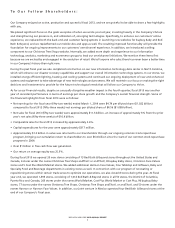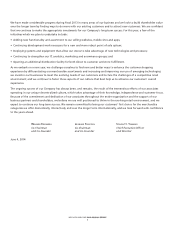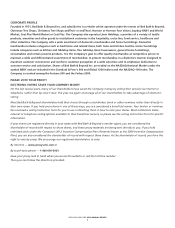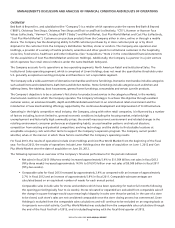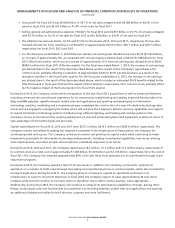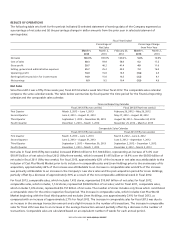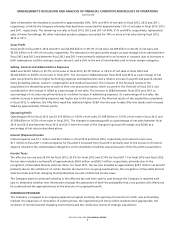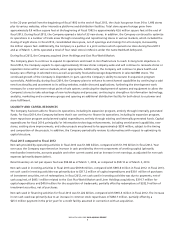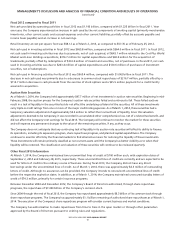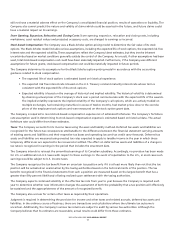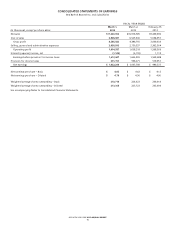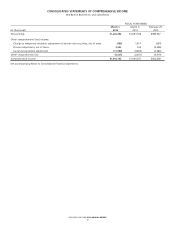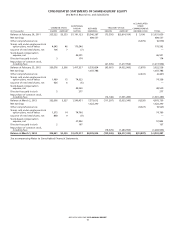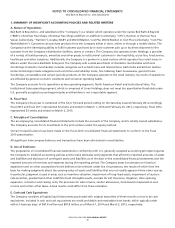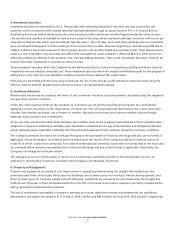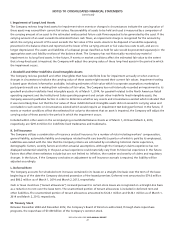Bed, Bath and Beyond 2013 Annual Report Download - page 14
Download and view the complete annual report
Please find page 14 of the 2013 Bed, Bath and Beyond annual report below. You can navigate through the pages in the report by either clicking on the pages listed below, or by using the keyword search tool below to find specific information within the annual report.At any one time, inventories include items that have been written down to the Company’s best estimate of their realizable value.
Judgment is required in estimating realizable value and factors considered are the age of merchandise and anticipated demand.
Actual realizable value could differ materially from this estimate based upon future customer demand or economic conditions.
The Company estimates its reserve for shrinkage throughout the year based on historical shrinkage and any current trends, if
applicable. Actual shrinkage is recorded at year end based upon the results of the Company’s physical inventory counts for
locations at which counts were conducted. For locations where physical inventory counts were not conducted in the fiscal year,
an estimated shrink reserve is recorded based on historical shrinkage and any current trends, if applicable. Historically, the
Company’s shrinkage has not been volatile.
The Company accrues for merchandise in transit once it takes legal ownership and title to the merchandise; as such, an
estimate for merchandise in transit is included in the Company’s merchandise inventories.
Impairment of Long-Lived Assets: The Company reviews long-lived assets for impairment when events or changes in
circumstances indicate the carrying value of these assets may exceed their current fair values. Recoverability of assets to be
held and used is measured by a comparison of the carrying amount of an asset to the estimated undiscounted future cash
flows expected to be generated by the asset. If the carrying amount of an asset exceeds its estimated future cash flows, an
impairment charge is recognized for the amount by which the carrying amount of the asset exceeds the fair value of the
assets. Assets to be disposed of would be separately presented in the balance sheet and reported at the lower of the carrying
amount or fair value less costs to sell, and are no longer depreciated. The assets and liabilities of a disposal group classified as
held for sale would be presented separately in the appropriate asset and liability sections of the balance sheet. The Company
has not historically recorded any material impairment to its long-lived assets. In the future, if events or market conditions
affect the estimated fair value to the extent that a long-lived asset is impaired, the Company will adjust the carrying value of
these long-lived assets in the period in which the impairment occurs.
Goodwill and Other Indefinite Lived Intangible Assets: The Company reviews goodwill and other intangibles that have
indefinite lives for impairment annually or when events or changes in circumstances indicate the carrying value of these assets
might exceed their current fair values. Impairment testing is based upon the best information available including estimates of
fair value which incorporate assumptions marketplace participants would use in making their estimates of fair value. The
Company has not historically recorded an impairment to its goodwill and other indefinite lived intangible assets. As of
March 1, 2014, for goodwill related to the North American Retail operating segment and the Institutional Sales operating
segment and certain other indefinite lived intangible assets, the Company assessed qualitative factors in order to determine
whether any events and circumstances existed which indicated that it was more likely than not that the fair value of these
indefinite lived intangible assets did not exceed its carrying value and concluded no such events or circumstances existed which
would require an impairment test being performed. In the future, if events or market conditions affect the estimated fair
value to the extent that an asset is impaired, the Company will adjust the carrying value of these assets in the period in which
the impairment occurs.
Self Insurance: The Company utilizes a combination of insurance and self insurance for a number of risks including workers’
compensation, general liability, automobile liability and employee related health care benefits (a portion of which is paid by
its employees). Liabilities associated with the risks that the Company retains are estimated by considering historical claims
experience, demographic factors, severity factors and other actuarial assumptions. Although the Company’s claims experience
has not displayed substantial volatility in the past, actual experience could materially vary from its historical experience in the
future. Factors that affect these estimates include but are not limited to: inflation, the number and severity of claims and
regulatory changes. In the future, if the Company concludes an adjustment to self insurance accruals is required, the liability
will be adjusted accordingly.
Litigation: The Company records an estimated liability related to its various claims and legal actions arising in the ordinary
course of business when and to the extent that it concludes a liability is probable and the amount of the loss can be
reasonably estimated. Such estimated loss is based on available information and advice from outside counsel, where
appropriate. As additional information becomes available, the Company reassesses the potential liability related to claims and
legal actions and revises its estimated liabilities, as appropriate. The Company expects the ultimate disposition of these matters
MANAGEMENT’S DISCUSSION AND ANALYSIS OF FINANCIAL CONDITION AND RESULTS OF OPERATIONS
(continued)
BED BATH & BEYOND 2013 ANNUAL REPORT
12


